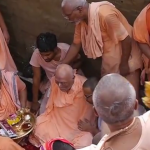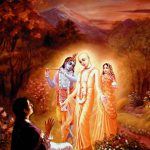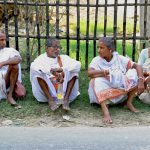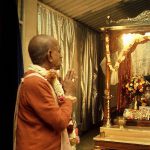by Swami B.V. Tripurari
First and foremost among Caitanya Mahaprabhu’s dearmost and closest associates is Gadadhara Pandita. He appeared in Bharatpura and also lived in Sridhama Mayapura as the neighbor of Caitanya Mahaprabhu. His mother had a sisterly relationship with Sacimata, Caitanya Mahaprabhu’s mother, so their families were very close. Externally, Mahaprabhu and Gadadhara had very different dispositions. Mahaprabhu was assertive, especially with regard to such things as learning and logic, but Gadadhara Pandita was very introverted, keeping in the background. He was also very much a Vaishnava in his overt behavior, whereas Caitanya Mahaprabhu did not exhibit his lila of being a Vaishnava until after he was initiated by Isvara Puri. Gadadhara Pandita, always happy to meet advanced Vaishnavas and render service to them, also learned from Isvara Puri when he spent time at Sacimata’s house. Thus the lives of these two great personalities overlapped considerably from the external point of view, and even more so from an internal view.
In Gaura lila, Krishna and Radha appear as Gaura and Gadadhara. Although Gadadhara is Radha and Caitanya Mahaprabhu is Krishna, svayam bhagavan himself, when they appear in Gaura lila there is some difference. Pujyapada Sridhara Maharaja has used an example to illustrate this: when, in traditional society, a husband and wife would worship the deity together, they remained as husband and wife, but would put aside their conjugal relationship under vow of service to the deity. Similarly, under the influence of this particular lila, the overtly conjugal relationship of Radharani and Krishna was unmanifest. Instead of the madhurya, sweetness, of Radha and Krishna’s Vraja lila, Gaura and Gadadhara’s lila is characterized by audarya, or magnanimity. We find Gadadhara very magnanimous and kind-hearted. Like a shadow he followed Mahaprabhu, pointing only to him.
Because Gadadhara is fully Radharani, other moods of the Goddess also find expression in him: that of Rukmini, Lalita-sakhi, and we could even say some semblance of Candravali, who appears in Dvaraka as Rukmini. Rukmini and Candravali’s dispositions appear in Gadadhara in Puri, which represents Dvaraka. In Dvaraka the position of the right-wing, submissive gopi Candravali is present in Rukmini, who gets the principal role there, and Gadadhara’s character is also very introverted, unlike Caitanya Mahaprabhu or Radharani. We don’t find assertiveness in Gadadhara Pandita’s relatonship with Caitanya Mahaprabhu, except maybe occasionally in some small way, as in Mayapura, when Mahaprabhu was madly in search of Krishna and Gadadhara Pandita attempted to pacify him saying, “Oh, Krishna is coming soon, so don’t worry. Calm down. He’s in your heart.” Here Gadadhara showed the assertive mood of Lalita, Radha’s expansion. Mahaprabhu then began tearing at his chest to get into his heart, and Gadadhara had to stop him. Seeing this, Sacimata told Gadadhara, “You stay with Nimai always. Protect him.” But even Gadadhara’s occasional instruction was not done in a dominant way and certainly never involved getting angry with Mahaprabhu, for his nature was far too gentle and submissive.
When Gadadhara heard Mahaprabhu was going to Puri, he went also and began to live there, making a vow never to leave Jagannatha Puri. Later, Caitanya Mahaprabhu left Puri to go to Vrindavana, and Gadadhara Pandita followed him, forsaking his vow without another thought. Other devotees went—Rupa, Sanatana, Jagadananda Pandita, and many others. But ultimately Mahaprabhu would not allow Gadadhara to stay and sent him back. And it is in Puri, returning in separation from Mahaprabhu, that we find Gadadhara’s mood most resembles Rukmini/Candravali. There also he showed sympathy for Vallabha and initiated him, and in Vallabha’s lineage Candravali takes a prominent role.
This doesn’t mean that Gadadhara Pandita is only Rukmini and not Radha, but that as Radha, he can also accommodate the mood of Rukmini, Lalita-sakhi, etc. In Gaura-ganoddesa-dipika we find that Gadadhara is thought to be an incarnation of both Radha and of Lalita. When Mahaprabhu in Nadiya manifests the bhava of Radha, which he does not necessarily do all the time, he takes that bhava from Gadadhara, and Gadadhara takes the position of Lalita. Again, in Puri he manifests the bhava of Rukmini/Candravali. So Gadadhara Pandita is a theologically complex person, as is Srimati Radharani.
Just as Gadadhara Pandita is multi-faceted, so too is Jagannatha Puri, being simultaneously identified with Dvaraka, and Kuruksetra. We may wonder why Caitanya Mahaprabhu never went to Kuruksetra. The reason is that the Ratha-yatra in Puri represents Krishna’s meeting with the gopis and the other residents of Vraja at Kuruksetra after a long time of separation. Therefore he may be said to have visited Kuruksetra annually. Demonstrating the correspondence of Puri and Kuruksetra, Bhaktivinoda Thakura sometimes expressed a desire to retire in Kuruksetra, but he made a practical effort to retire in Puri. He wanted to retire there because he thought the necessity of his goddess, Srimati Radharani, was so great at that place, having come so close to again having union with Krishna but not being able to go the final few feet, as depicted in Srimad-Bhagavatam. And it is Gadadhara Pandita who regularly recited Srimad-Bhagavatam to Mahaprabhu in Puri Dhama.
Gadadhara represents an unparalleled opportunity for service, because he represents Srimati Radharani fully, but in a particular condition relative to the lila. That lila is that Krishna has come in search of what she sees in him, what she tastes, what she experiences. And in order to do that, he tries to assume her bhava. This leaves Gadadhara Pandita, in the poetic language of Srila Sridhara Maharaja, as practically a barren person, with his essence extracted from him. Krishna in the form of Mahaprabhu has drawn the bhava, the essence, from Gadadhara, and Gadadhara, like a shadow, is following Mahaprabhu everywhere. As one’s shadow follows him, Gadadhara is following Mahaprabhu—Radharani trying to get her essence back. So needy is Gadadhara Pandita in separation! In this he magnanimously shows the way. He points only to Mahaprabhu, to Radha bhava—Radha indirectly pointing to herself. Such is her nature.










